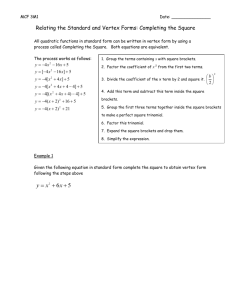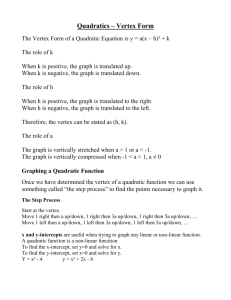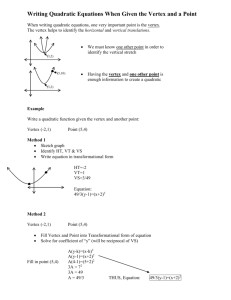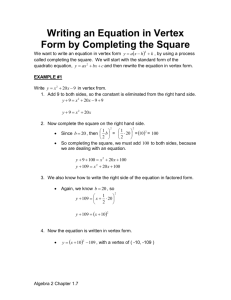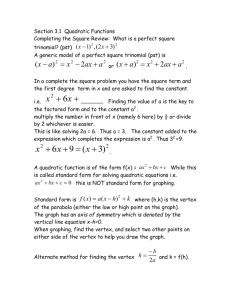Lesson 3-5: Completing the Square
advertisement
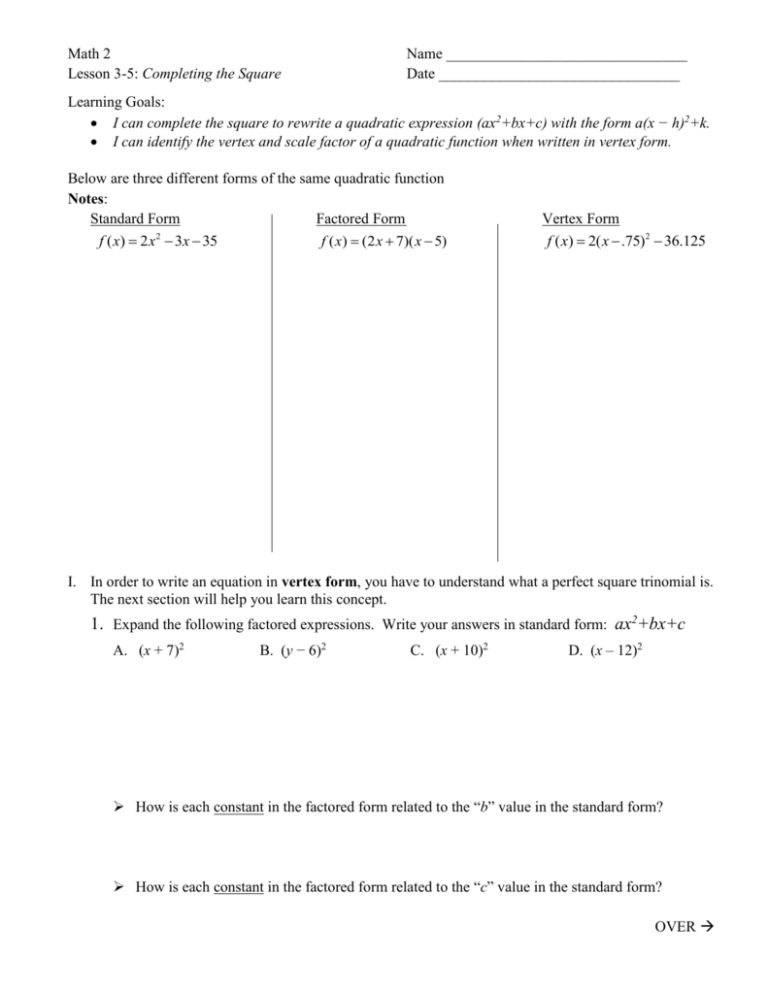
Math 2 Lesson 3-5: Completing the Square Name ________________________________ Date ________________________________ Learning Goals: I can complete the square to rewrite a quadratic expression (ax2+bx+c) with the form a(x − h)2+k. I can identify the vertex and scale factor of a quadratic function when written in vertex form. Below are three different forms of the same quadratic function Notes: Standard Form Factored Form 2 f ( x) (2 x 7)( x 5) f ( x) 2 x 3x 35 Vertex Form f ( x) 2( x .75)2 36.125 I. In order to write an equation in vertex form, you have to understand what a perfect square trinomial is. The next section will help you learn this concept. 1. Expand the following factored expressions. Write your answers in standard form: ax2+bx+c A. (x + 7)2 B. (y − 6)2 C. (x + 10)2 D. (x – 12)2 How is each constant in the factored form related to the “b” value in the standard form? How is each constant in the factored form related to the “c” value in the standard form? OVER Page 2 2. Apply your observations from #1 to fill in the blanks. Part (A) is done for you. Perfect Square Trinomial Factored Form A. x2 + 8x +16 (x + 4)2 B. x2 − 8x +16 ___________ C. ___________________ (x – 3)2 D. x2 +10x + 25 ___________ E. x 2 18 x _____ ___________ F. x 2 10 x _____ ___________ G. x 2 7 x _____ ___________ Why do you think these trinomials are called perfect square trinomials? 3. Let’s consider the example from the notes on the front of this page: f ( x) 2( x .75)2 36.125 Underline the perfect square trinomial in the equation. Any equation written in vertex form automatically has a perfect square trinomial in it. Being able to convert a quadratic function from standard form to vertex form requires using a technique called completing the square – you “complete” the perfect square trinomial. Example: Rewrite the equation f ( x) x 10 x 47 in vertex form. Goal: Vertex Form: y = a(x − h) 2 + k 2 Page 3 II. Practice: 1. The following problems represent quadratic equations in standard form. Write the equations in vertex form: y a( x h)2 k . y x 2 12 x Vertex: ________________ Max or Min Stretch/Compress/Neither y x2 9x Vertex: ________________ Max or Min Stretch/Compress/Neither h( x) x 2 14 x 20 Vertex: ________________ Max or Min Stretch/Compress/Neither h( x) x 2 32 x 12 Vertex: ________________ Max or Min Stretch/Compress/Neither OVER Page 4 Example: Rewrite the equation f ( x) 2 x 8 x 11 in vertex form. 2 2. Change the following into vertex form: y 3x 2 12 x 1 Vertex: ________________ Max or Min Stretch/Compress/Neither y 5x 2 10 x 3 Vertex: ________________ Max or Min Stretch/Compress/Neither Lesson 3-5 Homework Directions: Write the following equations in vertex form. Then identify the following: Vertex If the vertex is a max or min If the parabola is stretched, compressed or neither. 1. y x2 4x 2 3. y x 2 5x 5 2. y x 2 14 x 5 4. y x 2 10 x OVER 5. f x 2 x2 14 x 21 6. f x 3x2 18x 7. y 2 x 2 8 x 8. y 2 x 2 23x 8 9. y .02 x 2 5 x 10. y .4 x 2 5x 10
